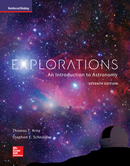1 2 3 4 5 6 7 6 solar masses. Compare your answer to the path of star S0-20 in figure 16.26.8 6 solar masses for its mass. How many AU is the Schwarzschild radius?9 6 solar mass black hole at the center of the Galaxy may have gained its first million solar masses in the first billion years of the Milky Way's existence. How much mass must it have absorbed on average each year since then to reach 5 million solar masses today?





